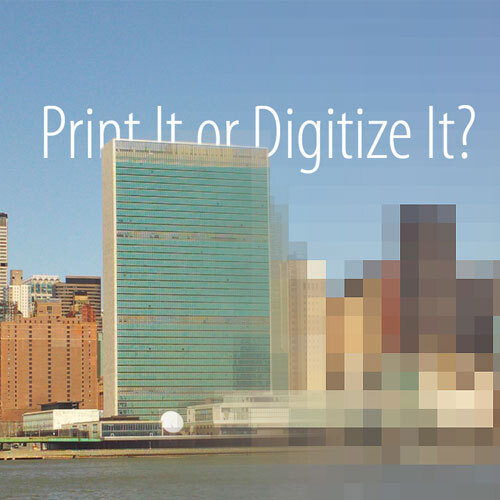
Designing to lower impacts
Should we print or not print to ease the burden on the environment? It is a question that should be addressed if only to dispel the presumptions we make. Many of us presume that we should opt for a website or PDF instead of a printed piece to make our communications easier on the environment. After all, paper is the largest industrial user of water per pound of finished product1 and the third largest user of fossil fuels2. So its no wonder that we might jump to the conclusion that if we are being sustainable, we should use anything but paper.
That’s where a life-cycle assessment (LCA) comes in handy. The LCA considers the inputs and outputs throughout the entire lifecycle of a product from its manufacturing to its disposal. This allows us to compare the potential impacts of information delivered digitally or printed and distributed. Unless you design by hand, the actual design of a piece whether for print or PDF will use just as much energy, so this consequence will remain constant. For most designers, it is at the production phase that the majority of our impacts are likely to be generated.
Four years ago the Royal Institute of Technology in Stockholm performed an LCA on a printed newspaper, a web-based newspaper and a tablet e-newspaper3. While many of us might presume that print would come out the loser, the findings held a surprise. When read for 10 minutes the printed newspaper had the greatest environmental impact while e-paper devices like the Kindle proved to be least impactful. But, when reading time on the web increased from 10 minutes to 30 minutes the potential impact grew and eventually the web-based newspaper became the worst offender. The fact is, computer use energy. For every eight hours I work at my computer I generate between 40-80 grams of CO24 per hour. And that’s only if I stay within my own network.
Driving people to a website, downloading, emailing all have an effect greater than we might expect. One in-depth online search generates approximately seven grams of greenhouse gases5. Multiple global servers are referenced simultaneously in an effort to provide the fastest results. Servers may be located in Europe, the US, Japan or China. The more rare and unusual the search, the more time we will spend searching. Even sending an email releases nine grams of CO2 into our atmosphere6. Our decisions on how to communicate and the call to action for our clients have an impact.
A 2007 Forest Product Association of Canada LCA7 report found that almost 95 per cent of the impacts in the production of office paper took place during its manufacture and its end of life disposal. This explains why paper has such negative environmental ramifications. The best bet: choose a mill using sustainable practices such as water recycling systems and alternative power; use certified fibre sources and increased recycle content; and reduce print quantities and sizes wherever possible.
When designing consider that a single, individual use printed piece is generally wasteful. But the reality is that printed work can, in some cases, be a more ecological solution than digital alternatives if we have identified that the piece will reach a large number of individuals who will repeatedly read the information and share it. And it is also helpful to remember that we should minimize online activities where feasible, but favour them when they replace more wasteful energy-intensive activities like driving.
It’s no doubt that sustainability makes a new demand on designers. It demands that we work closely with our suppliers, that we help change the creative brief and move our practice from what it is now, to what it can be. What we’re really talking about here is sustainable thinking. If we continue to educate ourselves, deferring to scientific fact to better understand how and when our work impacts the planet rather than making simplified claims that print is bad and digital is good, we take the first step towards sustainability.
1. Source: American Forest and Paper Association.
2. Source: American Forest and Paper Association, (Garner, J.W.. Energy Conservation Practices Offer Environmental and Cost Benefits. Pulp & Paper, October 2002).
3. Screening environmental life cycle assessment of printed, web based and tablet e-paper newspaper; Åsa Moberg, Martin Johansson, Göran Finnveden and Alex Jonsson; Reports from the KTH Centre for Sustainable Communications, Stockholm, Sweden 2007; ISSN: 1654-479X.
4. Definition: Carbon Dioxide (CO2): A naturally occurring gas, and also a by-product of burning fossil fuels and biomass, as well as land-use changes and other industrial processes. It is the principal anthropogenic greenhouse gas that affects the Earth’s radiative balance. It is the reference gas against which other greenhouse gases are measured and therefore has a Global Warming Potential of 1. Intergovernmental Panel on Climate Change, Third Assessment Report; Glossary
5. Revealed: The Environmental Impact of Google searches, by Jonathan Leake and Richard Woods, January 11, 2009.
6. The Carbon Footprint of Email Spam, McAfee Resource Center, 2009.
7. Printing and Writing Papers Life-Cycle Assessment, Conducted by the National Council for Air and Stream Improvement Inc. This study used a 20 lb. text weight paper with four per cent recycled content.
—
Looking to contribute to the national conversation and elevate the Canadian design communications profession? Submit your article to our editorial team: designcurrency@descan.ca